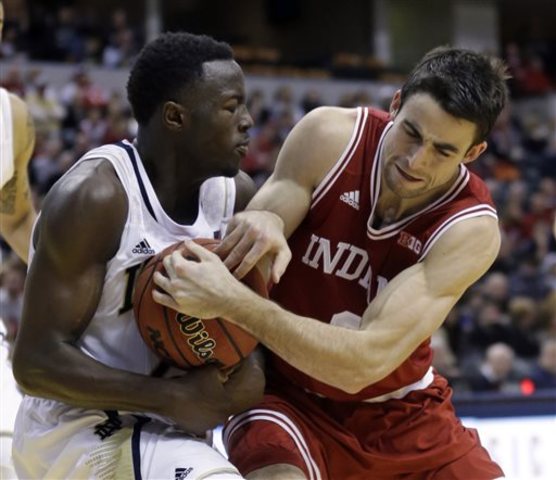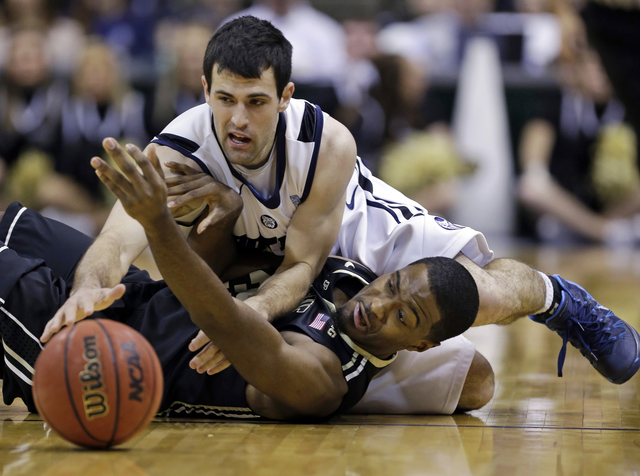Indiana and Purdue Both Face Questions Following Crossroads Classic
Posted by Jonathan Batuello on December 16th, 2013It wasn’t a good day for the Big Ten contingent at the Crossroads Classic in Indianapolis on Saturday. Indiana and Purdue both lost games they really needed to win, and now find themselves still without a marquee win on their NCAA resumes. The losses also gave Indiana (1-2 in Crossroads Classic history) and Purdue (0-3) losing records versus their in-state brethren Notre Dame (2-1) and Butler (3-0) in the event. So maybe the B1G schools don’t actually rule the state after all. Here are three keys from each of Saturday’s games and some questions facing the Hoosiers and Boilermakers following each.
Notre Dame 79, Indiana 72

Indiana’s Will Sheehey battles with Notre Dame’s Jerian Grant for a ball in the Crossroads Classic. Indiana faces plenty of questions following the loss to the Irish (AP Photo/Michael Conroy).
- Physicality Inside. Everyone thought it would be the Notre Dame guards who could lead the Irish to an upset victory, but everyone was pretty much wrong. Jerian Grant had a very good game (23 points), but it was the Irish’s inside play of Garrick Sherman (16/6) and bench players Tom Knight (yes, he still plays basketball) and Zach Auguste that killed Indiana inside. These players routinely went right at Vonleh and the other Hoosiers and just outmuscled them in the paint. The Hoosier freshman is very athletic and talented but he had no answer when they backed him down. This is an issue that could rear its head often for this team during Big Ten play if Vonleh doesn’t toughen up or the Hoosiers don’t find someone to match up defensively with the strong inside players in the conference.
- Go-to Scorer. Indiana never took the lead in this game despite coming close over and over again. The Hoosiers would pull within a few points or tie the game and could never quite get over the hump. Each time, Indiana either froze on assessing its options or the leaders who tried to take charge didn’t come through. Examples included Will Sheehey quickly pulling up for a three-pointer and missing, or Yogi Ferrell taking an isolation drive that was rejected. These two or someone else needs to emerge for Indiana to close out games like these in the future.
- Losing At What It’s Best At. Maybe it’s best just to let Tom Crean’s quote after the game describe it: “Our identity has got to be in the fact that going into the game, we were fifth in the country in field goal percentage defense, we were No. 1 in the country in rebound margin, we were way up in the country in getting to the free throw line. None of those things worked out to our advantage today.” Crean’s right. Indiana outrebounded the Irish by three, let them shoot 46.3 percent from the field, and only took 16 free throw attempts. When the things you mark as your strengths don’t come through in a big game, it usually isn’t going to go well for your team.
Butler 76, Purdue 70
- Turnovers and Finishing. Purdue committed 18 turnovers against a Butler team of which it couldn’t afford to do so. On the other end of the court, the Boilermakers actually caused 15, yet couldn’t convert many of the opportunities. At one point in the first half Purdue missed fast break layups on three consecutive possessions — good teams can’t make mistakes like that and win big games.
- AJ Hammons’ Foul Trouble. The biggest advantage Purdue had in this game was its size inside with Hammons. No Butler player could match up against the Boilers’ big man but his foul trouble kept him off the floor for a large chunk of the game (he played 24 minutes). When Hammons is on the floor and focused, he is a difference-maker, but against better teams he often gets in foul trouble and heads to the bench (he has averaged 3.8 fouls per game in contests against power conferecne teams plus Butler). Even Matt Painter recognized this after the game, saying that he needs to coach him better on not fouling while he still remaining a good defender.
- Offensive Identity. Against Butler (and every game for Purdue, really), there seemed to be two types of offense that clashed against one another. For guards Ronnie Johnson, Terone Johnson and Bryson Scott, unabashed drives to the basket to make something happen seem to be a standard play. Sometimes, it works great and the Boilermakers notch a layup or uncontested floater. Other times, though, the defense collapses to clog the lane and the guards turn it over or are forced into a ridiculously tough, off-balance shots with no escape valve. On the other side is Hammons, who usually takes too much time to think about what he wants to do when he receives the ball. He often waits more than five seconds before either passing out or making a move to the basket, which often allows help to come to him and force a turnover. Purdue needs to reconcile its offense between these two approaches, with guards slowing down on one hand, and Hammons making quicker decisions with the ball on the other.










































